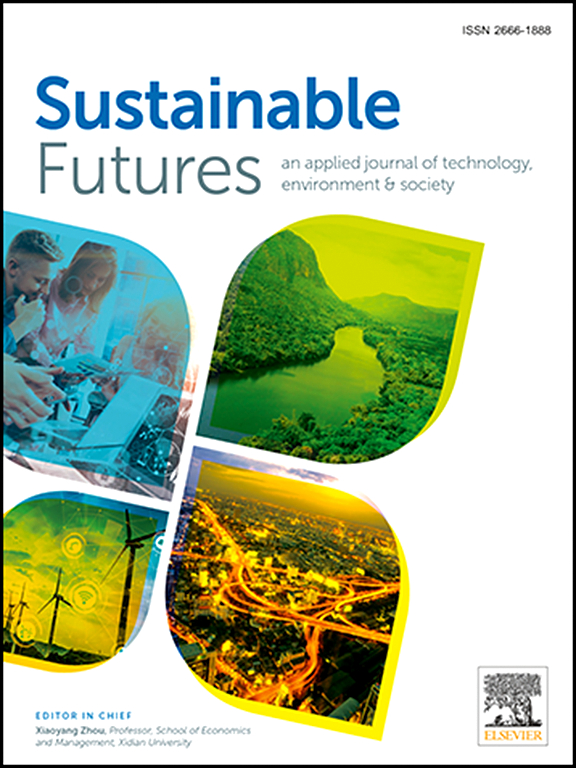Delineation of groundwater potential zones and recharge using multi-source big data and systematic analysis approach
IF 4.9
2区 社会学
Q2 ENVIRONMENTAL SCIENCES
引用次数: 0
Abstract
Groundwater is vital for all living things. A thorough comprehension of groundwater management is crucial, as careful use and replenishment can address various concerns. The distribution of groundwater tables, slope, landform, drainage pattern, lithology, topography, geological structure, fracturing density, fracture opening and connectivity, land use, and land cover influence the occurrence and efficiency of groundwater in an aquifer system. The integration of geospatial techniques, such as Remote Sensing (RS), Geographic Information Systems (GIS) and the Analytical Hierarchy Process (AHP), is a crucial tool for analyzing, monitoring, and safeguarding groundwater supplies by identifying potential zones. Twelve groundwater-regulating factors have been considered in the analysis, including rainfall, geology, drainage density, soil, slope, aspect, roughness, hilshade, lineament density, land use/land cover, as well as flood and landslide data. We allocated theme weight and class rank to every thematic layer through weighted overlay analysis. Fieldwork corroborated the results, leading to the creation of a groundwater potential map (GWPZ). The delineated GWPZ watershed is classified into five categories: the very low GWPZ covers 12.5 % of the area, the low GWPZ covers 25 %, the medium GWPZ covers 37.5 %, the high GWPZ covers 20 %, and the very high GWPZ covers 5 % of the area. The northeastern region of the basin is classified as a low groundwater potential zone, whereas the southern area demonstrates a high groundwater potential. The results validated the GWPZ using field data from five wells in the research region, demonstrating a good accuracy rate of 85 %. This study provides a scientific basis for informed decision-making on groundwater usage and conservation for environmental and societal well-being, supporting water resource management and sustainable development.
基于多源大数据和系统分析方法的地下水潜力带及补给圈定
地下水对所有生物都是至关重要的。彻底了解地下水管理是至关重要的,因为仔细使用和补充地下水可以解决各种问题。地下水位分布、坡度、地貌、水系格局、岩性、地形、地质构造、压裂密度、裂缝张开度和连通性、土地利用和土地覆盖等因素影响着含水层系统中地下水的赋存和效率。地理空间技术的整合,如遥感(RS)、地理信息系统(GIS)和层次分析法(AHP),是通过确定潜在区域来分析、监测和保护地下水供应的关键工具。在分析中考虑了12个地下水调节因子,包括降雨、地质、排水密度、土壤、坡度、坡向、粗糙度、hilshade、线条密度、土地利用/土地覆盖以及洪水和滑坡数据。通过加权叠加分析,为每个主题层分配主题权重和类别排名。实地工作证实了这一结果,从而建立了地下水潜力图(GWPZ)。将划定的GWPZ流域划分为5类:极低GWPZ占12.5%,低GWPZ占25%,中GWPZ占37.5%,高GWPZ占20%,极高GWPZ占5%。盆地东北部为低潜势区,南部为高潜势区。利用研究区5口井的现场数据,验证了GWPZ的准确性,准确率达到85%。该研究为地下水利用和保护的知情决策提供了科学依据,以促进环境和社会福祉,支持水资源管理和可持续发展。
本文章由计算机程序翻译,如有差异,请以英文原文为准。
求助全文
约1分钟内获得全文
求助全文
来源期刊

Sustainable Futures
Social Sciences-Sociology and Political Science
CiteScore
9.30
自引率
1.80%
发文量
34
审稿时长
71 days
期刊介绍:
Sustainable Futures: is a journal focused on the intersection of sustainability, environment and technology from various disciplines in social sciences, and their larger implications for corporation, government, education institutions, regions and society both at present and in the future. It provides an advanced platform for studies related to sustainability and sustainable development in society, economics, environment, and culture. The scope of the journal is broad and encourages interdisciplinary research, as well as welcoming theoretical and practical research from all methodological approaches.
 求助内容:
求助内容: 应助结果提醒方式:
应助结果提醒方式:


